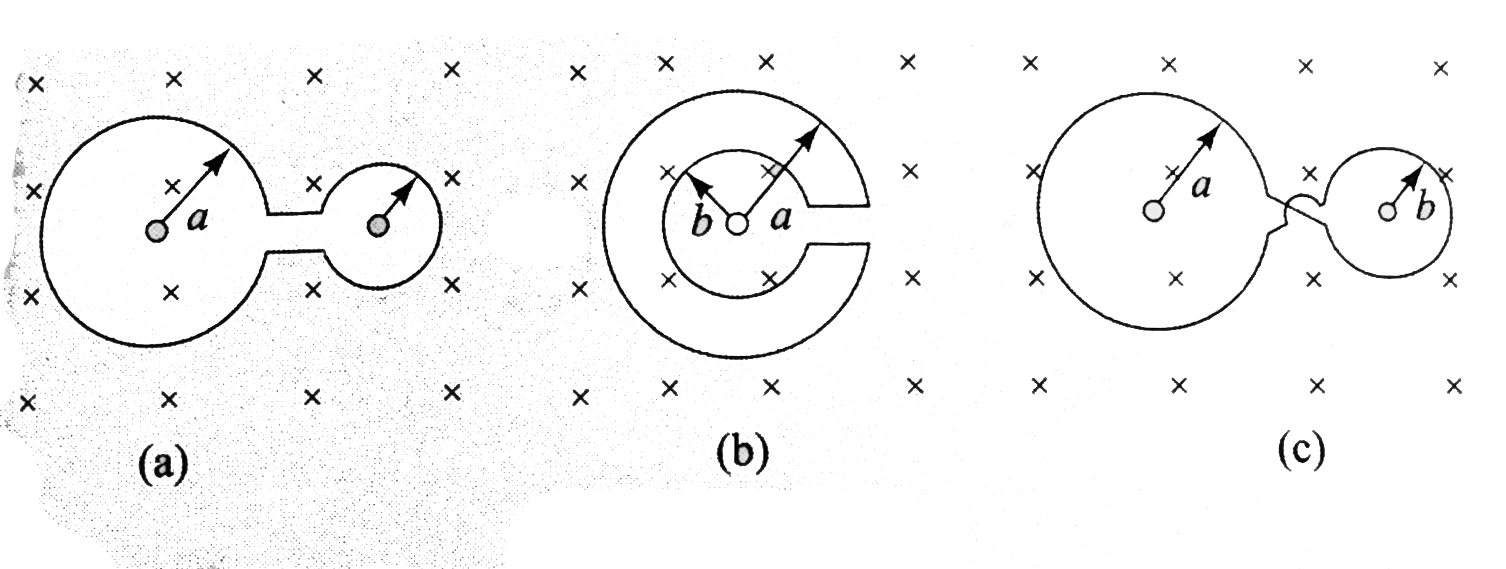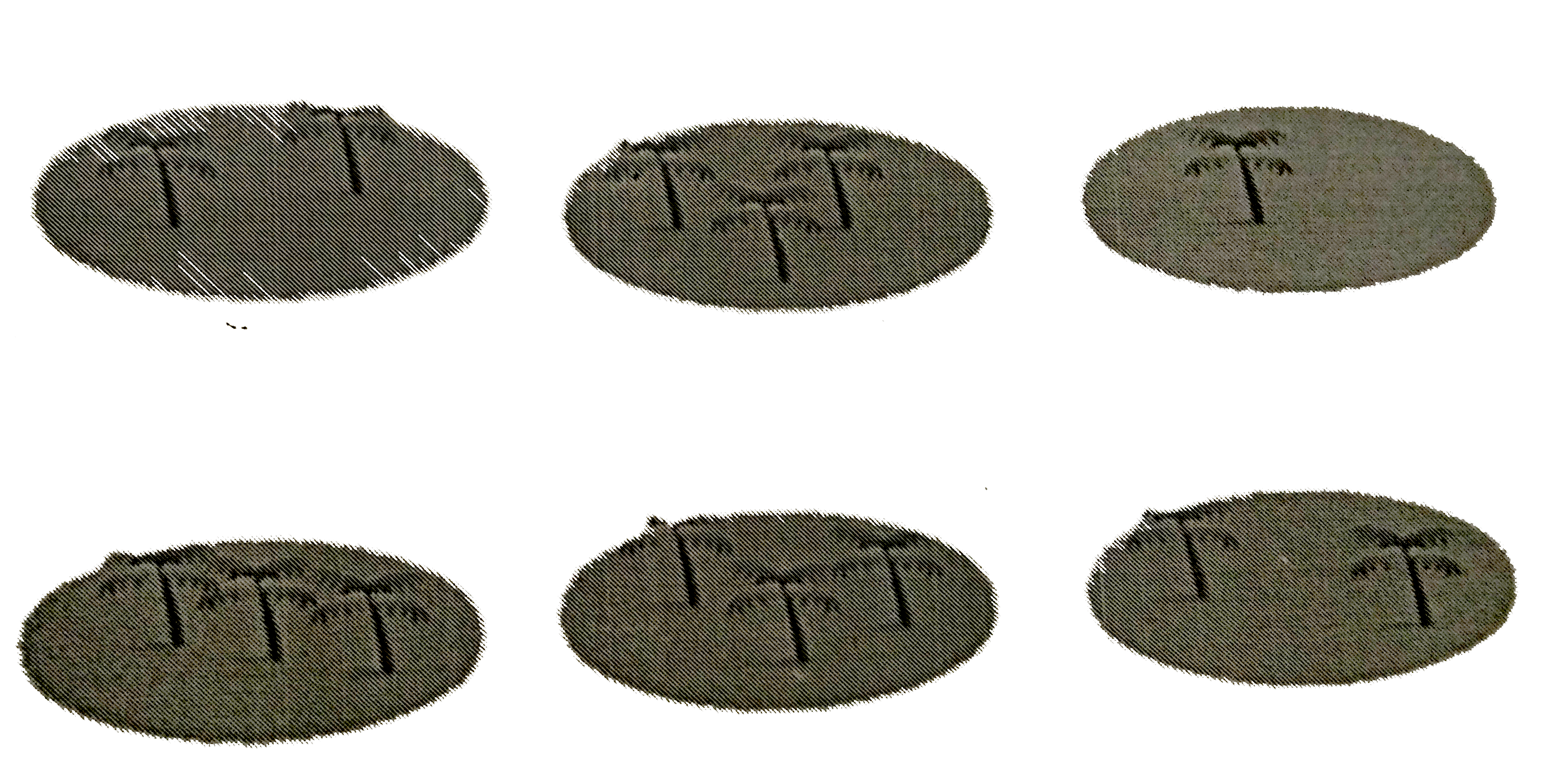Try to recall the uniform pattern found in a necklace of beads joined with the help of a thread Fig. 3.1 (a) given on Textbook, (P. 32). Or, try to join a number of paper clips together to make a long chain, as in Fig. 3.1 (b). Is there any similarity between the two?
Yes. Both are a chain of small units joined together.
Similar Questions
Figure 3.15(a) shown two circular rings of radii a and b (a>b) joined together with wires of negligible resistance. Figure 3.15(b) shown thew pattern obtained by folding the small loop in the plane of the large loop.
(a)
The pattern shown in Fig.3.15( c ) is obtained by twisting the small loop of Fig.3.15(a) through 180∘.
All the three arrangement are placed in a uniform time varying magnetic field dB/dt=k, perpendicular to the plane of the loops. if the resistance per unit length of the wire is λ, then determine the induced current in each case.
View SolutionFigure 3.15(a) shown two circular rings of radii a and b (a>b) joined together with wires of negligible resistance. Figure 3.15(b) shown thew pattern obtained by folding the small loop in the plane of the large loop.
(a)
The pattern shown in Fig.3.15( c ) is obtained by twisting the small loop of Fig.3.15(a) through 180∘.
All the three arrangement are placed in a uniform time varying magnetic field dB/dt=k, perpendicular to the plane of the loops. if the resistance per unit length of the wire is λ, then determine the induced current in each case.
View Solution
Knowledge Check
Numerous forms of the periodic table have been revised from time to time. A modern verion, which is most convenient and widely used is the long or extended from the periodic table. The aufbau principle (electrons are filled in the progressive order of their increasing energy i.e., by n + l rule) and the electronic configuration of atom provides a theoretical foundation for the periodic classification. The horizontal rows are called periods. There are altogether seven periods. The first period consists of 2 elements. The subsequent periods consist of 8, 8, 18 and 32 elements respectively. The seventh maximum of 32 elements. Elements having similar outer electronic configurations in their atoms are grouped in vertical columns. These are referred to as groups or famillies. According to the recommendation of IUPAC, the groups are numbered 1 to 18 replacing the older notation of groups 0, IA, IIA ..... VIIA, VIII, IB, ...... VII B. Each successive period in the periodic table is associated with the filling up of next higher principal energy level following aufbua sequence. The number of elements in each period is twice the number of atomic orbitals avaliable in the energy level that is being filled. All the elements are classified into four blocks, i.e., s-block, p-block, d-block and f-block depending on the type of atomic orbitals that are being filled with the last electron of the element.
Elements a,b,c,d and e have the following electronic configurations.
(a) 1s2,2s22p1
(b) 1s2,2s22p)(6),3s23p1
(c) 1s2,2s22p6,3s23p1
(d) 1s2,2s22p6,3s23p5
(e) 1s2,2s22p6,3s23p5
Which among these will belong to the same group in periodic table?Aa and cBa and bCa and bDd and e
Three rods of identical cross - section and length are made of three different material of thermal conductivity k1,k2 and k3 respectively. They are joined together at their ends to make a long rod (See figure). One end of the long rod is maintained at 100∘C and the other at 0∘C ( See figure ). If the joints of the rod are at 70∘C and 20∘C in steady state and there is no loss of energy form the surface of the rod, the correct relationship between k1,k2 and k3 is
View SolutionThree stones are projected simultaneously with same speed u from the top of a tower. Stone 1 is projected horizontally and stone 2 and stone 3 are projected making an angle q with the horizontal as shown in fig. Before stone 3 hits the ground, the distance between 1 and 2 was found to increase at a constant rate u.

(a) Find θ
(b) Find the rate at which the distance between 2 and 3 increases.
View SolutionFive identical conducting plates, 1,2,3,4 and 5 are fixed parallel pltes equidistant from each other (see figure). A conductor connects plates 2 and 5 while another conductor joins 1 and 3. The junction of 1 and 3 and the plate 4 are connected to a source of constant emf V0. Find

(a) the effective capacity of the system between the terminals of source.
(b) the charges on the plates 3 and 5. Given, d= distance between any two successive plates and A= area of either face of each plate.
View SolutionFive identical conducting plates, 1,2,3,4 and 5 are fixed parallel pltes equidistant from each other (see figure). A conductor connects plates 2 and 5 while another conductor joins 1 and 3. The junction of 1 and 3 and the plate 4 are connected to a source of constant emf V0. Find

(a) the effective capacity of the system between the terminals of source.
(b) the charges on the plates 3 and 5. Given, d= distance between any two successive plates and A= area of either face of each plate.
View SolutionThe location of the next puzzle was the Isle of Drear, a combination of 6 islands joined by a system of bridges designed by Dumbledore himself. Madame Maxime gives Fleur the same condition that Dumbledore was posed with when he was designing the network of bridges. Madame Maxime asked Fleur the total number of distinct ways to join the six islands shown above by bridges such that:
1. each island can be reached from any other island via the bridges,
2. 1 of the islands has 1 bridge leading from it
3. 2 of the islands each have 2 bridges leading from them, and
4. 3 of the islands each have 3 bridges leading from them.
Madame Maxime also gave some more details and assumptions:
1. Neither of the 2 islands on the far left can be joined directly to either of the 2 islands on the far right.
2. There can be more than 1 bridge between 2 islands.
3. Mirror images and 180-degree rotations are not counted as distinct.
4. Diagonal bridges are not allowed. As the next round of the tournament was set up by Dumbledore, Madame Maxime thought it could help Fleur if she thought in the same lines as Dumbledore once did. Can you guess the total number of ways?

View SolutionMake a point P and draw a circle with centre P and radius 5 cm. Take any point Q on the circle drawn. With Q as centre and radius 3 cm draw another circle. Label the two points at which the circles intersect as A and B. Join PQ and AB. Find the angle between AB and PQ.
View SolutionTwo wires W1andW2 have the same radius r and respective densities p1andp2 such that p2=4p1. They are joined together at the point O, as shown in the figure. The combination is used as a sonometer wire and kept udner tension T. The point O is midway between the two bridges. When a stationary waves is set up in the composite wire, the joint is found to be a node. The ratio of the number of antinodes formed in W1toW2 is-

View Solution
